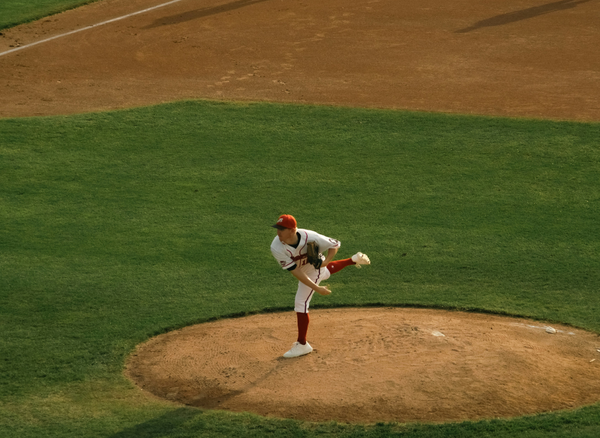Have you ever caught a fly ball at a baseball game and thought: Wow, this little sphere of stitches and leather has some serious heft!? Well, you're not alone! The weight of a baseball is a finely tuned aspect of America's favorite pastime, and it's about time we give it the spotlight it deserves. So grab your peanuts and Cracker Jacks, and let's dive into the just how much a baseball weighs.
The Official Scoop on Baseball Weight
When it comes to the weight of a baseball, there's no room for guesswork – the rules are as strict as a no-nonsense umpire's strike zone.
That's about the weight of a deck of cards or a fluffy hamster – but please, don't try to shuffle a baseball or cuddle it like a pet.
This weight range isn't just a random decision made by some baseball bigwigs; it's the sweet spot that ensures the game is fair and consistent. Imagine a pitcher hurling a baseball that weighs as much as a bowling ball – it would be game over for both the batter and the catcher's mitt!
A Peek Inside the Baseball Factory
Ever wondered what goes into making a baseball so perfectly ponderous? It all starts with a cork and rubber core, affectionately known as the "pill," which is roughly the size and weight of a bouncy ball you'd get from a gumball machine. But don't let its playful appearance fool you; this core means serious business.
Wrapped around the pill are layers of yarn – about 370 yards of it, to be exact. That's long enough to stretch around the bases on a baseball diamond nearly four times! This yarn is what gives the baseball its heft and helps it fly true when smacked by a bat. The final touch is the white cowhide leather, stitched together with 108 red stitches – the iconic look of a baseball. This leather doesn't just make the ball look pretty; it also adds to the overall weight and helps pitchers grip and spin the ball with precision.
The Role of Weight in the Game
The weight of a baseball isn't just a trivial factoid; it's a crucial element that affects every pitch, hit, and catch. A heavier ball might not travel as far when hit, turning potential home runs into warning track outs. On the flip side, a ball that's too light could turn the game into a home run derby, and nobody wants to see pitchers sobbing on the mound.
Pitchers, in particular, have a love-hate relationship with the weight of the ball. They need it to be just right to throw those knee-buckling curveballs and eye-popping fastballs. If the ball were any lighter, it might just float to the plate, and if it were heavier, well, we'd need to call in the bodybuilders to take the mound.
The Evolution of Baseball Weight
Believe it or not, baseballs haven't always weighed the same. Back in the olden days of the sport, the weight of a baseball was as unpredictable as a game of pin the tail on the donkey. Early baseballs were made from a variety of materials, including shoe rubber and even old stockings – talk about a funky fastball!
It wasn't until 1872 that the powers-that-be decided to standardize the weight of the ball, and thank goodness they did. Before that, you might as well have been playing catch with a lumpy potato. The standardization of the baseball's weight helped the sport evolve into the precise and skillful game we know and love today.
The Impact of Weather on Baseball Weight
Now, you might think that once a baseball is made to the correct weight, that's the end of the story. But hold on to your hats, because the weather can play some sneaky tricks on our beloved ball. Humidity and temperature can cause the leather to expand or contract, making the ball slightly heavier or lighter.
This is why some teams store their baseballs in climate-controlled environments – it's not because the balls need to be pampered like a bunch of divas; it's to keep the playing field level. After all, no one wants to play a game where the ball is as unpredictable as the weather forecast.
The Science Behind the Swing
When a batter steps up to the plate, the weight of the baseball is a critical factor in the physics of their swing. A heavier ball requires more force to hit it far, which means batters need to have both strength and timing down to a science. It's like trying to hit a piñata that's filled with sand instead of candy – it takes a good whack to get the goodies.
This is why players spend countless hours in the batting cages, perfecting their swing to match the weight of the ball. It's not just about muscle; it's about understanding the science of momentum and energy transfer. Who knew baseball could be such a brainy sport?
The Art of Pitching a Perfect Weight
Pitchers, those maestros on the mound, have their own set of challenges when it comes to the baseball's weight. They need to grip, spin, and release the ball in a way that maximizes its weight to their advantage. It's like juggling eggs – you need the perfect touch to avoid a mess.
The weight of the ball affects everything from the speed of the pitch to the movement of the ball as it zips (or dances) towards the plate. A well-weighted ball can be the difference between a strikeout and a grand slam – no pressure, pitchers!
The Weighty Debate: Does Size Matter?
Now, you might be thinking, "What about the size of the baseball? Doesn't that affect the weight?" And you'd be right – size and weight go hand in hand like peanuts and Cracker Jacks. A baseball's circumference is strictly regulated, measuring between 9 and 9.25 inches. This ensures that the weight is distributed evenly across the ball, making it fair for everyone.
But don't get too hung up on the size – it's the weight that really packs the punch. After all, a baseball isn't trying to win a beauty contest; it's there to be thrown, hit, and caught with precision and power.
The Weight Goes On: Maintenance and Care
Maintaining the weight of a baseball is a bit like taking care of a pet rock – it doesn't require much, but you still need to show it some love. Baseballs can get scuffed, dirty, and worn out, which can affect their weight and performance. That's why umpires are always on the lookout for balls that need to be retired from the game.
Teams also go through hundreds of baseballs every season, ensuring that each one is up to snuff. It's a never-ending cycle of weighing, inspecting, and replacing – all in the name of keeping the game fair and fun.
The Cultural Heft of Baseball's Weight
Lastly, let's not forget the cultural significance of a baseball's weight. It's a symbol of the game's history and tradition, a constant in a world that's always changing. The weight of a baseball is a reminder that some things, like the joy of a sunny day at the ballpark, are timeless.
So next time you're watching a game, take a moment to appreciate the humble baseball and its carefully calibrated weight. It's not just a piece of sports equipment; it's a testament to the precision and care that goes into America's favorite pastime.
Baseball Weight FAQs
Well, let's be honest, the internet is a vast ocean of information, but finding a straight answer to this seemingly simple question can be as elusive as hitting a home run on your first try. Worry no more, my friend! We've gathered the most frequently asked questions about baseball weight and compiled them all in a convenient section. So whether you're a curious fan or just trying to settle a bet, we've got you covered with all the quirky knowledge you need. Let's dive in and satisfy your baseball weighing curiosity!
Why is the weight of a baseball important?
The weight of a baseball is crucial because it affects how the ball behaves when pitched, hit, and caught. It ensures consistency in the game and allows players to perform at their best.
Can the weight of a baseball change during a game?
Yes, factors like weather conditions can slightly alter the weight of a baseball during a game. However, umpires and teams work to maintain the balls within the official weight range.
How is the weight of a baseball determined?
The weight of a baseball is determined by its core, the layers of yarn, and the leather covering. These materials are carefully selected and combined to meet the official weight standards set by MLB.
Summary
In the grand slam of sports trivia, the weight of a baseball is a home run of a topic. We've pitched you the facts, from the official weight range of 5 to 5.25 ounces to the materials and manufacturing process that contribute to its heft. We've also explored the impact of weight on the game, the evolution of baseball standards, and the influence of weather conditions. Plus, we've delved into the physics of batting and pitching, the relationship between size and weight, and the importance of maintenance and care. It's clear that the weight of a baseball is more than just a number – it's a fundamental part of the sport that requires consistency.









